Back to business today and a Spring Tour around the Cley area looking for migrants. It was slightly cool and cloudy first thing up on the coast, in a light north wind, but the sun came out and it warmed up in the afternoon – a lovely April day.
We started off looking – or listening – for Nightingales, which have started to arrive in the last few days. As we got out of the car, we could hear plenty of warblers singing – a couple of Blackcaps, several Chiffchaffs and a Cetti’s Warbler. With all the sounds around us, it felt like a real spring morning. We heard a Bullfinch call and a smart pink male perched up briefly in the bushes in front of us. But there was no sound of the Nightingale at first.
We began to walk down the road. A couple of Long-tailed Tits were calling from the hedgerow and as they flew up we could see some grey lichen in the area they had been – a closer look confirmed our suspicions and we found a beautiful nest tucked in amongst the branches. As we stopped to admire it, the Nightingale started singing back where we had been – but only two brief snatches of song before it went quiet again. It seemed like it might still be too chilly for it to really get going.
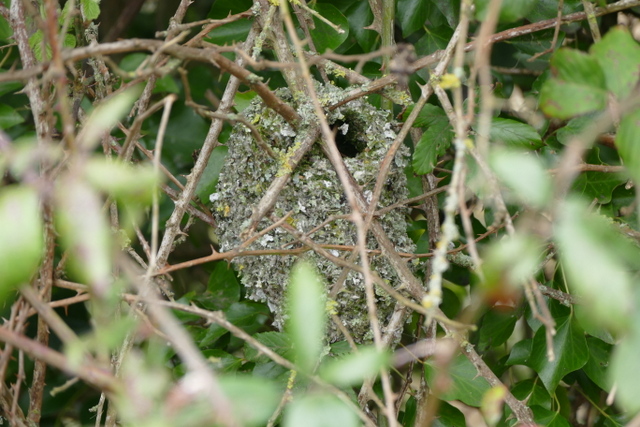 Long-tailed Tit nest – an amazing construction, well concealed in the hedge
Long-tailed Tit nest – an amazing construction, well concealed in the hedge
Continuing back down the road, we stopped every so often to listen to the bird song around us. A Whitethroat or two were new additions for the day – we got a look at one smart male – and a Lesser Whitethroat rattled from deep in the bushes but didn’t similarly oblige. A male Cuckoo sang from the trees, really adding to the feeling of spring, and then we heard the amazing bubbling sound of a female nearby. We got a look at her perched up in a tree before she flew across the road behind us. Unfortunately, a Cuckoo is not as common a sight (or sound) now as it used to be.
We had gone some way down the road when a second Nightingale started singing just behind us. We turned and walked back a short way to listen to it. It was a delight just to stand there and hear the song, the liquid phrases rolling out from the dense undergrowth. After a while it stopped singing and we could hear it calling (a bit like a frog!), before it flew across the road and disappeared into the hedge the other side, flashing a russet tail as it did so. We listened to it singing there for a while, close beside us, catching another glimpse of it in flight before it finally went quiet again and we headed back. What a magical moment. As we walked back to the car, a Tawny Owl hooted from the trees – not what we were expecting in the middle of the morning!
Heading down to the coast, our next stop was Walsey Hills. There had been a Black Redstart hanging around opposite here for the last couple of days, but there was no sign today. We had a quick explore along the footpath, and had a good look at a couple of Willow Warblers which were singing from the bushes. But with no sign of any more life, we didn’t hang around.
Further along the coast road, we pulled up outside the visitor centre at Cley. Our intention had been to use the facilities and get a cup of coffee first, but from the car park we could already hear the Grasshopper Warbler reeling from the bushes just across the road. We didn’t want to miss the opportunity to get a good look at it, particularly as it has been performing so well of late, so we walked over to see it. Unfortunately, by the time we got over there it had already decided to go quiet. Typical! We stood for a while, and the call of the coffee was growing ever more tempting when we caught a couple of quiet reels. The Grasshopper Warbler sounded like it had moved much further away. Then suddenly it hopped up into some low brambles not 5 metres in front of us. We got a great look at it as it sang in short bursts and clambered about in the nettles close to the ground. After that, we celebrated with a coffee in the visitor centre!
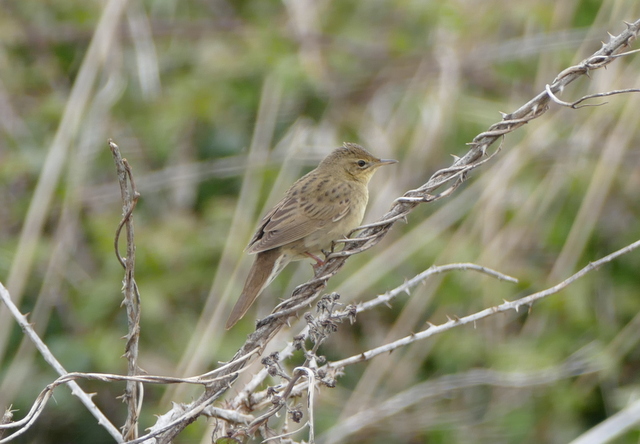 Grasshopper Warbler – reeling right in front of us today
Grasshopper Warbler – reeling right in front of us today
We were planning to explore the reserve later in the day, so after our coffee we headed back along the coast to Kelling. As we walked down along the lane, a Red Kite drifted over and disappeared to the west. The cows are out on the water meadow early this year and that seemed to have pulled in the Yellow Wagtails. But the first bird we saw was not a typical ‘Yellow’, but a very smart male Blue-headed Wagtail, the continental European subspecies. We got him in the scope and set about admiring his blue-grey crown and striking white supercilium, which contrasted with his bright yellow underparts. As we did so, a male British Yellow Wagtail appeared next to him. As we scanned in amongst the cows feet, we eventually picked up four of them – three males and a duller female. One of the male Yellow Wagtails in particular sat preening in the grass and positively glowed bright canary yellow in the (now) sunshine.
 Blue-headed Wagtail – with 4 Yellow Wagtails amongst the cows today
Blue-headed Wagtail – with 4 Yellow Wagtails amongst the cows today
Down at the pool, there were several Black-tailed Godwits and Avocets wading around in the water. Amongst them was a stunning Spotted Redshank in mostly black summer plumage. Flushed by some walkers along the cross track, it flew towards us and started to feed close by. We admired its white eye-ring, contrasting with the blackish head and neck, the white-spotted upperparts and the long and needle-tipped bill.
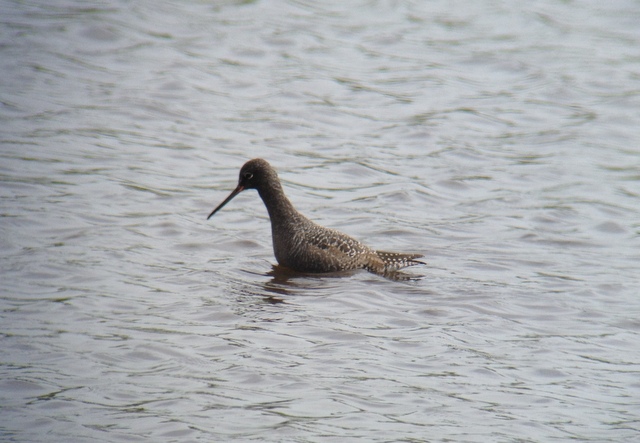 Spotted Redshank – a smart bird, in fine black summer plumage
Spotted Redshank – a smart bird, in fine black summer plumage
That wasn’t the only good wader down on the pool today. It was hiding on the island at first, but eventually the Knot appeared. It was starting to live up to its proper name of ‘Red Knot‘, beginning to moult into its much brighter summer plumage, rather than the grey winter grab with which we are more familiar. The resident Egyptian Geese had already hatched three goslings, already starting to look quite well grown.
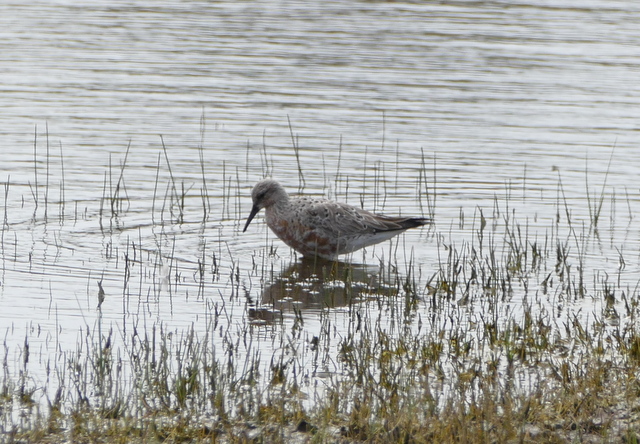 Red Knot – or ‘Reddish Knot’ perhaps still at the moment
Red Knot – or ‘Reddish Knot’ perhaps still at the moment
We carried on down towards the beach and up onto the top, hoping that we might pick up a Wheatear or Whinchat. No sign of either of those, but we did find a couple of pairs of Stonechat, presumably local breeding birds. One of the males decided to come down the fence line towards us – another smart bird! As we stood there admiring it, we could hear a Mediterranean Gull calling and after a while we picked up a pair of adults, flashing their white wing-tips, circling high above the field behind.
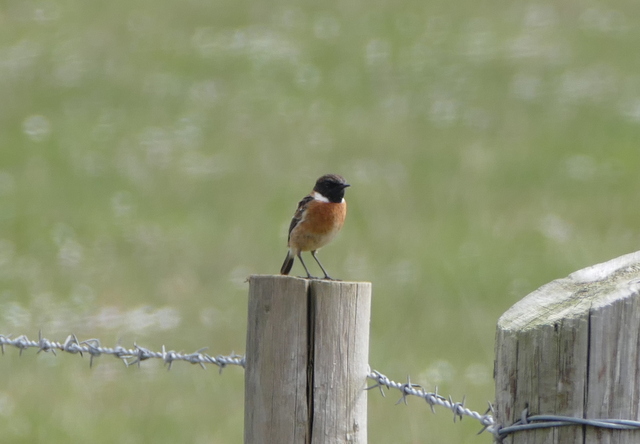 Stonechat – one of the males at Kelling today
Stonechat – one of the males at Kelling today
The morning was long gone, so we eventually managed to tear ourselves away and head back to the car. We drove a short way along the coast to Salthouse for a late lunch on the Beach Road. While we ate, we picked up a small group of Wheatear out on the grazing marshes. A Greenshank appeared on the pools behind the beach.
After lunch, we drove back to Cley and headed out to explore the reserve. The main scrapes were fairly quiet – a smattering of duck (Wigeon, Gadwall, Teal, Mallard & Shoveler), a few Black-tailed Godwits and lots of Avocets. Looking more closely, we found a pair of Little Ringed Plovers on one of the islands, displaying. There were also lots of Ruff (& Reeves). The first ones we saw still appeared to be in mostly winter plumage, but eventually we found a male with lots of black on head and neck, clearly moulting into summer plumage. It was a good opportunity to look at the variation, and the differences between males and females.
 Shelduck – this pair were mating right outside the hide
Shelduck – this pair were mating right outside the hide
The Eye Field seemed a bit quiet as we drove down Beach Road. However, a scan from the car park revealed four Wheatears out on the grass. We set out to walk towards North Hide and as we did so, a lovely male Whinchat appeared on the fence. It was quite flighty and wouldn’t settle near us, but we eventually got it in the scope – another cracker. On the edge of the shingle, we stopped to admire a Ringed Plover on one of the pools and as we did so, we picked up a White Wagtail by the grass. Unfortunately, it didn’t linger and flew off out into the Eye Field and disappeared from view. We did manage to find it again, looking from further along, and got a good look through the scope. A nice haul of classic spring migrants for the list for the day.
 Whinchat – a smart male on the Eye Field fence
Whinchat – a smart male on the Eye Field fence
Billy’s Wash had a few ducks on it, including three Pintail, one of them a smart male. North Scrape was fairly quiet – just a couple more Little Ringed Plover and a few of the other Cley regulars. Then it was time to start heading back, stopping briefly to admire a female Wheatear right by the fence.
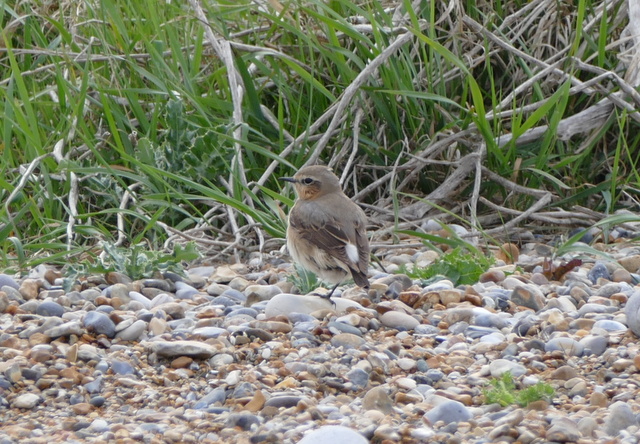 Wheatear – we saw a few at Salthouse & Cley today
Wheatear – we saw a few at Salthouse & Cley today
We had met in Wells, so made our way back there to finish. A single Common Seal (or perhaps more appropriately ‘Harbour’ Seal) was pulled up and resting nearby.
All-in-all, a decent haul of early spring migrants and incoming breeding birds for the day.















